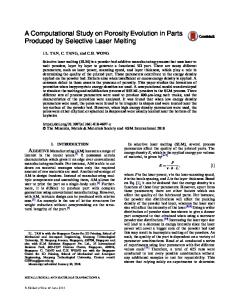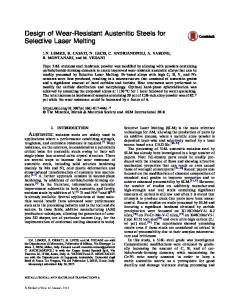A computational phase transformation model for selective laser melting processes
- PDF / 5,044,957 Bytes
- 22 Pages / 595.276 x 790.866 pts Page_size
- 18 Downloads / 276 Views
ORIGINAL PAPER
A computational phase transformation model for selective laser melting processes Isabelle Noll1
· Thorsten Bartel1 · Andreas Menzel1,2
Received: 15 April 2020 / Accepted: 7 August 2020 © The Author(s) 2020
Abstract Selective laser melting (SLM) has gained large interest due to advanced manufacturing possibilities. However, the growing potential also necessitates reliable predictions of structures in particular regarding their long-term behaviour. The constitutive and structural response is thereby challenging to reproduce, due to the complex material behaviour. This motivates the aims of this contribution: To establish a material model that accounts for the behaviour of the different phases occurring during SLM but that still allows the use of (basic) process simulations. In particular, the present modelling framework explicitly takes into account the mass fractions of the different phases, their mass densities, and specific inelastic strain contributions. The thermomechanically fully coupled framework is implemented into the software Abaqus. The numerical examples emphasise the capabilities of the framework to predict, e.g., the residual stresses occurring in the final part. Furthermore, a postprocessing of averaged inelastic strains is presented yielding a micromechanics-based motivation for inherent strains. Keywords Additive manufacturing · Finite element method · Abaqus · Residual stress · Phase transformations
1 Introduction Additive manufacturing (AM) refers to processes where a part is fabricated by sequential addition of material rather than by subtractive manufacturing or moulding. Thus, the final part has little geometrical and material restrictions. Customised parts can be produced within a reasonably low cost range and comparative short amount of time. AM is often called a near-net-shaping technique, as the part is directly built based on a computer aided design (CAD) model. The CAD model is then converted into a standard triangulation language (STL) format which is widely used for all AM machines. It represents the geometry of the CAD model by a simple mesh. This file is digitally sliced into thin crosssectional layers and can then be constructed by the chosen AM process. The layering is carried out through deposition and bonding of these layers. Thus, no tools are required to initiate the AM process (except for necessary post-processing).
B
Isabelle Noll [email protected]
1
Institute of Mechanics, TU Dortmund, Leonhard-Euler-Str. 5, 44227 Dortmund, Germany
2
Division of Solid Mechanics, Lund University, P.O. Box 118, 221 00 Lund, Sweden
Nowadays, there are various technologies, differing in the used material (mostly powder or wire), in the heat source and in the procedure in general. In this contribution, the focus lies on the selective laser melting (SLM) process, also referred to as laser powder-bed fusion as summarised in, e.g. [14], where a work piece is manufactured in a—in this case—metal powder bed. The process uses a laser beam as the heat source to selec
Data Loading...











